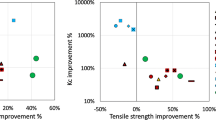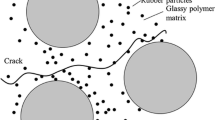Abstract
The effects of a process zone on toughness and on R-curve behavior were investigated for a model, rubber-modified epoxy polymer. The system studied was one in which the bridging mechanism of toughening does not operate. The characteristic features of R-curve behavior, a rise in toughness with crack extension until an approximate steady-state is reached, were observed using double-cantilever-beam tests. The evolution of the process zone was studied using transmission-optical microscopy. As the crack grew, the process zone appeared to fan out until it reached a steady-state thickness; it then remained a uniform size upon further crack advance. The features of the experimental R-curves were shown to be directly correlated to the evolution of the process zone. Furthermore, the effect of the portion of the process zone in the crack wake was examined by a series of experiments in which the wake was partially removed, and the R-curve re-established by subsequent loading. These experiments demonstrated that removal of the crack wake caused the crack-growth resistance to drop. The toughness then built back up to the steady-state value as the crack wake re-developed. This unambiguously demonstrated a contribution to toughening from the crack wake despite the absence of any observable bridging mechanism. These results support the accepted notion that an extrinsic toughening mechanism is responsible for the increased toughness observed upon adding rubber particles to an epoxy matrix
Similar content being viewed by others
References
Bascom, W.D., Cottington, R.L., Jones, R.L. and Peyser, P. (1975). The fracture of epoxy-and elastomer-modified epoxy polymers in bulk and as adhesives. Journal of Applied Polymer Science 19, 2545-2562.
Bascom, W.D. and Cottington, R.L. (1976). Effects of temperature on the adhesive fracture behavior of an elastomer-epoxy resin. Journal of Adhesion 7, 333-346.
Budiansky, B., Hutchinson, J.W. and Lambrapolous, J.C. (1983). Continuum theory of dilatant transformation toughening in ceramics. International Journal of Solids and Structures 19, 337-355.
Cook, R.F. and Clarke, D.R. (1988). Fracture stability, R-curves and strength variability. Acta Metallurgica 36, 555-562.
Crouch, B.A. and Huang, D.D. (1994). The J-integral technique applied to toughened nylons under impact loading. Journal of Material Science 29, 861-864.
Evans, A.G. and Faber, K.T. (1984). Crack-growth resistance of microcracking brittle materials. Journal of American Ceramic Society 67, 255-260.
Evans, A.G., Ahmad, Z.B., Gilbert, D.G. Gilbert, and Beaumont, P.W.R. (1986). Mechanisms of toughening in rubber-toughened polymers. Acta Metallurgica 34, 79-87.
Hashemi, S. and Williams J.G. (1991). Single and multi-specimen R-curve methods for J I C determination of toughened nylons. Journal of Materials Science 26, 621-630.
Holik, A.S., Kambour, R.P., Hobbs, S.Y. and Fink, D.G. (1979). Grinding and polishing techniques for thin sectioning of polymeric materials for transmission light microscopy, Microstructural Science 7, 357-367.
Huang, Y. and Kinloch, A.J. (1992). Modelling of the toughening mechanisms in rubber-modified epoxy polymers. Part II: A quantitative description of the microstructure-fracture property relationships. Journal of Materials Science 27, 2763-2769.
Kinloch, A.J. and Guild, F.J. (1996). Predictive modeling of the properties and toughness of rubber-toughened epoxies. (Edited by C.K. Riew and A.J. Kinloch), Toughened Plastics II: Novel Approaches in Science & Engineering, American Chemical Society, Washington, D.C.
Kinloch, A.J., Shaw, S.J., Tod, D.A. and Hunston, D.L. (1983a). Deformation and fracture behavior of a rubber-modified epoxy: 1. Microstructure and fracture studies. Polymer 24, a 1341-1354.
Kinloch, A.J., Shaw, S.J. and Hunston, D.L. (1983b). Deformation and fracture behavior of a rubber-modified epoxy: 2. Failure criteria. Polymer 24, b 1355-1363.
Knehens, R. and Steinbrech, R. (1982). Memory effect of crack resistance during slow crack growth in notched Al2O3 bend specimen. Journal of Materials Science Letters 1, 327-329.
Kunz-Douglass, S., Beaumont, P.W.R. and Ashby, M.F. (1980). A model for the toughness of epoxy-rubber particulate composites. Journal of Materials Science 15, 1109-1123.
Mai, Y.-W. and Lawn, B.R. (1986). Crack stability and toughness characteristics in brittle materials. Annual Reviews of Materials Science 16, 415-439.
Marshall, D.B. and Swain, M.V. (1988). Crack resistance curves in magnesia-partially stabilized zirconia. Journal of American Ceramic Society 71, 399-407.
McMeeking, R.M. and Evans, A.G. (1982). Mechanics of transformation toughening in brittle materials. Journal of American Ceramic Society 65, 242-246.
Pearson, R.A. and Yee, A.F. (1986). Toughening mechanisms in elastomer-modified epoxies Part II: Microscopy studies. Journal of Materials Science 21, 2475-2488.
Pearson, R.A. and Yee, A.F. (1991). Influence of particle size and particle-size distribution on toughening mechanisms in rubber-modified epoxies. Journal of Materials Science 26, 3828-3844.
Rice, J.R. (1968). A path independent integral and the approximate analysis of strain concentration by notches and cracks. Journal of Applied Mechanics 35, 379-386.
Rose, L.R.F. and Swain, M.V. (1988). Transformation zone shape in ceria-partially-stabilized zirconia. Acta Metallurgica 36, 955-962.
Swain, M.V. and Hannink, R.J.H. (1984). R-Curve behavior of zirconia ceramics. (Edited by N. Claussen, M. Rühle and A.H. Heuer), Advances in Ceramics, Vol. 12, Science and Technology of Zirconia II. American Ceramic Society, Colombus, OH pp.225-240.
Swanson, P.L., Fairbanks, C.J., Lawn, B.R., Mai, Y.-W. and Hockey, B.J. (1987). Crack-interface grain bridging as a fracture-resistance mechanism in ceramics: I. Experimental study on alumina. Journal of American Ceramic Society 70, 279-289.
Tvergaard, V. and Hutchinson, J.W. (1992). The relation between crack growth resistance and fracture process parameters in elastic-plastic solids. Journal of the Mechanics and Physics of Solids 40, 1377-1397.
Wiederhorn, S.M., Shorband, A.M. and Moses, R.L. (1968). Critical analysis of the theory of the double cantilever method of measuring fracture-surface energies. Journal of Applied Physics 39, 1569-1572.
Yee, A.F. and Pearson, R.A. (1986). Toughening mechanisms in elastomer-modified epoxies Part I: Mechanical studies. Journal of Materials Science 21, 2462-2474.
Yee, A.F., Li, D. and Li, X. (1993). The importance of constraint relief caused by rubber cavitation in the toughening of epoxy. Journal of Materials Science 28, 6392-6398.
Yu, C.-S. and Shetty, D.K. (1989). Transformation zone shape, size and crack-growth-resistance (R-Curve) behavior of ceria-partially-stabilized zirconia polycrystals. Journal of American Ceramic Society 72, 921-928.
Yang, W, (1991). Toughness increment by crack growth in toughened structural materials. Acta Mechanica Sinica 7, 131-1139.
Zhou, Z., Landes, J.D. and Huang, D.D. (1994). J-R Curve calculation with the normalization method for toughened polymers. Polymer Engineering and Science 34, 128-134.
Author information
Authors and Affiliations
Rights and permissions
About this article
Cite this article
Du, J., Thouless, M. & Yee, A. Development of a process zone in rubber-modified epoxy polymers. International Journal of Fracture 92, 271–286 (1998). https://doi.org/10.1023/A:1007530801531
Issue Date:
DOI: https://doi.org/10.1023/A:1007530801531




